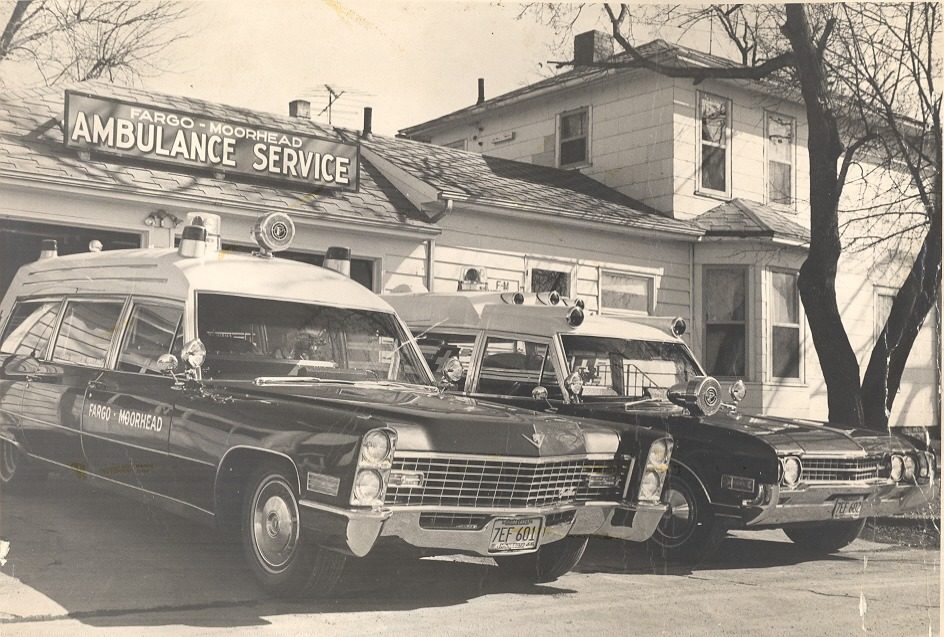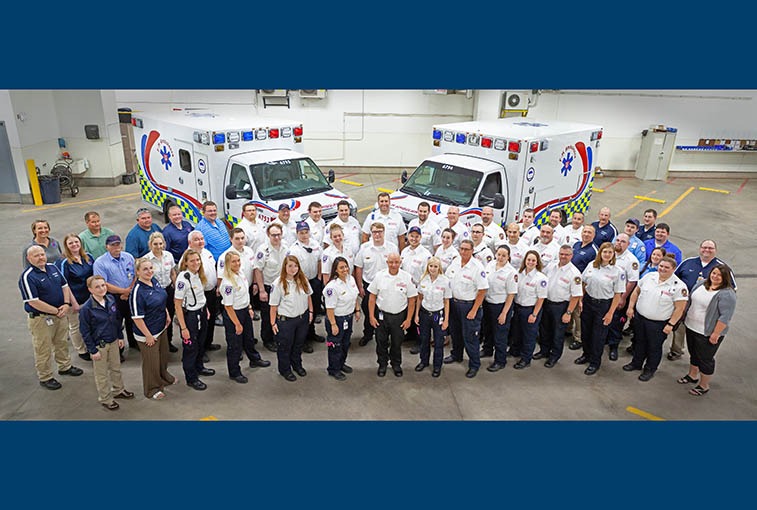F-M Ambulance began over 60 years ago with the goal of providing excellent patient care to the communities that they serve.
They have grown into one of the largest Emergency Medical Services (EMS) systems in the area and are the only ambulance service that is CAAS accredited in North Dakota and one of two in Minnesota.
They are a team of hard-working professionals who are dedicated to delivering world-class prehospital care to the people they love – friends, family and neighbors.
In celebration of its 60th anniversary, two longtime employees reminisced: Char Skaff, former education director and paramedic at F-M Ambulance, and Steven Briggs, M.D., former F-M Ambulance paramedic and now trauma surgeon at Sanford Health. They looked back on its growth, the impact it continues to make on the community, saving lives and the camaraderie between paramedics and hospital employees.
Growing through the years
F-M Ambulance began in 1959 as a single Cadillac hearse that was converted into a makeshift ambulance that served the Fargo-Moorhead area. Eventually it grew to two ambulances on duty during the day and one overnight in Fargo, North Dakota, and one during the day and overnight in Moorhead, Minnesota.
From there, it expanded to:
- Four ambulances during the day and three overnight
- Three of the ambulances working 24-hour shifts and one worked 8 a.m. to 5 p.m.
- Weekend shifts that began at 5 p.m. Friday and continued until 8 a.m. Monday
Then in 1996, F-M Ambulance switched to 12-hour shifts with five ambulances on duty during the hours of 2 a.m. to 5 a.m. and 12 on duty during its busiest hours starting at 2 p.m. Today their approach remains the same, but due to varying start times the number of ambulances depends on when and where they are needed.
Toward the beginning, the ambulance only had the capability to load and transport patients and give oxygen.
“They had a cot and would load and go,” Skaff said. “In those days we were lifting the 75-pound cot plus the weight of the patient, but now it’s all electronic.”
Watch video: See more photos from F-M Ambulance’s history
The service’s continued growth led to the ambulances carrying EKG machines on board.
“They were heavy compared to what they are today. I remember having to go downtown and carry that EKG machine with two hands,” Skaff said. “Now they hardly weigh anything, evolving from a huge life pack to something that is concise, smaller and lighter.”
Not only did the technology inside the ambulances change over the years, but so did the extent of what paramedics and emergency medical technicians (EMT) could do.
“At the time, we did basic care because we were basic EMTs. That means all you could do was bandage, stop bleeding, give oxygen and then take them to the hospital,” Skaff said. “But then, in 1980, the EMT intermediate program began, which meant we could start IVs, and eventually evolved into the paramedic program.”
The paramedic program revolutionized the type of care that could be given in the field during an emergency situation, impacting the lives of patients for the better.
“The ambulance has transformed into an emergency room in the field,” Skaff said. “We are doing physician and nursing skills inside the ambulance, the house, wherever they need us.”
Caring for the community
F-M Ambulance continues to have a profound impact on the community.
“They are the first line if you get hurt or an emergency situation arises,” Dr. Briggs said. “In many respects, they are the ones who make decisive interventions out in the field.”
Although they make quick decisions in dire situations, they never fail to provide exceptional patient care, regardless of the situation.
“It brings the utmost, top-notch medical care to the patient,” Skaff said. “You deliver babies, you hold a dying patient in your arms and then you hold their family members as well.”
F-M Ambulance has a team of highly trained and capable paramedics and EMTs. Their capability provides a sense of relief to hospital employees.
“I feel they are very competent and they have a good quality of improvement process,” Dr. Briggs said. “It helps me personally feel comfortable they are doing a good job out there in how they approach problems.”
The kind of care F-M Ambulance provides is crucial to patients and their recovery process.
“If you do the right things up front, patients are either going to get better faster or they won’t get as sick,” Dr. Briggs said. “It’s important to have people with that mindset out there taking the front line.”
The team at F-M Ambulance can be seen providing support not only through fire rehab and disaster prevention, but also at various special events, Heart Smart Communities, football games, the Sanford Fargo Marathon and concerts.
F-M Ambulance’s unique team
Being a paramedic or an EMT is more than taking classes, passing required tests and working shifts.
“It takes a certain personality and set of skills to do it successfully out there,” Dr. Briggs said. “You have to be flexible, cool under pressure, have tough skin and be able to set aside certain emotional responses to do your job.”
All of these unique skills help paramedics and EMTs excel in adapting to the unpredictable aspects of their job.
“Recognizing there are certain things you have to get done, but the scenario in which you have to do them isn’t going to be textbook,” Dr. Briggs said. “It’s going to be something random and it’s never going to be the same way twice.”
Adding to the uniqueness of their profession is their ability to give care out in the field.
“The prehospital environment is very different than being in a hospital,” Dr. Briggs said. “You have to be able to adapt to your environment and the circumstances in order to get the job done.”
Camaraderie and a lasting impact
Both Skaff and Dr. Briggs note the success of the program is due in part to camaraderie.
“The physicians who come to our classes to teach, the various doctors, surgeons and physician assistants who come to speak – they all contribute to our development. They don’t question it because they realize it is such an important program,” Skaff said.
This mutual trust extends out of the classroom in to emergency situations. Working as a united team allows professionals in the hospital to feel confident in the care F-M Ambulance is giving in the field as well as the care the patient receives in the hospital.
“You’re so relieved when you get to the ER and have 10 people opening that back door,” Skaff said. “You walk out of the ambulance after they take the patient out and your legs are jelly because you’re thinking, ‘What did we just do? We saved a life.’”
Regardless of the day or the emergency situation, F-M Ambulance has left a lasting impact on the community and those who were a part of it.
“That’s where I found my way. I realized what I wanted to do next through the training,” Dr. Briggs said. “If I hadn’t done that, I wouldn’t have been exposed to medicine in the way I was and I wouldn’t have gone the route I did.”
As for Skaff, she continues to reflect on her experiences.
“You know, you had your really tough days when things didn’t go as planned and then you had your really good days when you saved a life or you delivered a baby,” she said. “I miss it a lot. I miss the patient care, the camaraderie of the doctors; it was the most rewarding job I’ve ever done. I miss it immensely.”
F-M Ambulance has been training paramedics since 1982. What began as a small internal education team has grown to be the largest EMS education department in the region that provides training for rescue squads, ambulance services, fire departments, nurses and doctors.
The team also trains community members in CPR, first aid and babysitting. In 60 years, F-M Ambulance has grown to be the premier prehospital education center in the region.
More stories:
- Bystander CPR: Anyone can do it (now hands-only)
- Serving the community as an EMT
- Sanford AirMed: Air ambulances provide care in the air
…
Posted In Company News, Emergency Medicine

